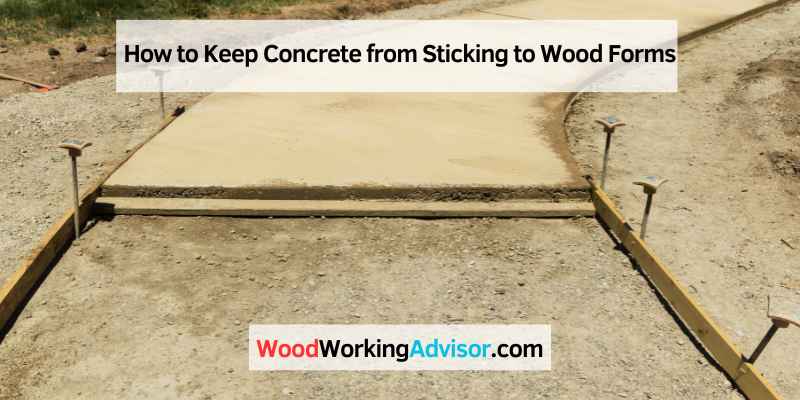To prevent concrete from sticking to wood forms, treat the wood with a release agent. Some lumber mills pre-treat the lumber with an oil-based blend or a barrier oil release agent such as linseed, mineral or paraffin to make it stick-resistant.
Otherwise, apply a release agent to the boards before building the formwork. Oil-based release agents are highly effective in reducing the need for frequent reapplication. Keeping the concrete from sticking to wood forms is crucial for achieving a smooth and even finished product.
We will explore the various methods and options for preventing this from happening, including the use of release agents, oils, and other mold release options. Whether you are a professional contractor or a DIY enthusiast, learning how to keep concrete from sticking to wood forms is an essential skill for any successful concrete project.
Using Form Oil
To prevent concrete from sticking to wood forms, it’s important to use a release agent. Oil-based agents like linseed, mineral, and paraffin oil are effective due to their long-lasting barrier protection. Apply the release agent to the boards before building the formwork using a hand-pump sprayer to ensure the surfaces facing the wet concrete are covered evenly.
wood Forms Using Form Oil
Using form oil is one of the easiest and most effective ways to keep concrete from sticking to wood forms. In this method, a release agent is applied to the wood surface before pouring the concrete. The mixture of oil and other chemicals creates a barrier between the concrete and wood, preventing adhesion. This process doesn’t just keep wood from sticking to concrete; it also prolongs the life of your wood forms. Read on to understand what is form oil, applications of form oil, removing the cylinders, fresh tests, and hardened tests.
What Is Form Oil?
Form oil is a chemical solution that is used to prevent concrete from sticking to wood forms. It’s a blend of several chemicals that create a thin layer of oil-based coating on the surface of wood. Apart from preventing concrete from sticking, it also repels water and prolongs the life of the forms. Form oil is available in various formulations and different brands, but they all serve the same purpose.
Applications Of Form Oil
Form oil is used in construction projects where concrete is poured over wooden forms. It can be applied to all types of wood surfaces, including plywood, lumber, and particleboard forms. The oil-based coating prevents the wood from absorbing moisture from the concrete which can cause it to stick. Form oil also prevents the concrete from spreading out unevenly, resulting in better finishes. Additionally, form oil is suitable for use in complex structures where the forms are intricate and challenging to remove.
Removing The Cylinders
Removing the cylinders from the wood forms becomes more comfortable when form oil is used. It makes the work less time-consuming and minimizes damage to the forms. After placing the concrete on the wood forms, wait for a minimum of 24 hours before removing the forms. Start by loosening the screws that hold the forms together. Then, use a pry bar to gently pull the forms apart. If there are any stubborn areas, a rubber mallet can be helpful in dislodging them. Finally, use sandpaper to smooth out the rough spots on the forms so that they can be reused.
Fresh Tests
Fresh tests refer to samples of concrete that have just been poured and allowed to set without being exposed to moisture or sunlight. After applying form oil to the wood surfaces, pour a sample of concrete into the forms and allow it to set. Once the concrete has hardened, remove the forms to check for any signs of sticking. If there are no issues, the concrete can be allowed to cure fully. If the concrete sticks to the wood, you may need to adjust your form oil application or choose a different release agent.
Hardened Tests
Hardened tests are carried out after the concrete has fully cured and hardened. It involves inspecting the concrete for any signs of discoloration or roughness that might have been caused by the wood forms. If the concrete shows signs of discoloration or roughness, it may be necessary to change the type of form oil or adjust its application. Always test any new form oil before using it for a large project to ensure that it produces the desired results.
In summary, using form oil is an effective method of preventing concrete from sticking to wood forms, extending the life of forms, and minimizing any potential damage during their removal. The oil-based coating creates a barrier between the wood and concrete, preventing adhesion. It’s important to test the form oil before use and to inspect the concrete after it has cured to ensure that there are no signs of discoloration or roughness. By following these tips, you can achieve a smooth and evenly finished concrete surface every time.
Mold Release Options For Concrete Casting

To prevent concrete from sticking to wood forms, a release agent can be used. Oil-based barrier release agents such as linseed and mineral oil can create a film that physically prevents concrete from adhering to the wood. Alternatively, beeswax can be applied directly to the mold or a mold release spray can be used.
Mold Release Options
When it comes to concrete casting, mold release options can make all the difference in the success of your project. One common issue that arises is concrete sticking to the wood molds, causing a headache for construction workers. Thankfully, there are a variety of mold release options available.
Olive Oil
Olive oil is one mold release option for concrete casting. Applying a layer of olive oil on the wood mold prevents the concrete from sticking during the casting process. This natural option provides an environmentally friendly solution to the problem of concrete adhering to wood.
Isopropyl Alcohol
Another option for preventing concrete from sticking to wood forms is isopropyl alcohol. This mold release option involves cleaning the surface of the mold with alcohol before applying a release agent. This method works by breaking the surface tension between the wood and concrete, preventing adhesion.
Beeswax
Beeswax is a natural and environmentally friendly mold release agent for concrete casting. Applying beeswax to the surface of the mold creates a barrier between the wood and concrete, preventing adhesion. This option is particularly useful for smaller molds that require intricate designs.
Applying Wax To The Mold
To apply wax to the concrete mold, heat the wax until it melts and apply it to the surface of the wood form with a brush. Wait until the wax hardens before pouring the concrete into the mold. This option provides a longer-lasting barrier against concrete sticking to the wood mold.
Applying A Mold Release Spray
Mold release sprays are also an effective option for preventing concrete from sticking to wood forms. These sprays create a barrier between the wood surface and the concrete, preventing adhesion. Make sure to apply the spray evenly across the surface of the mold to ensure complete coverage.
In conclusion, using mold release options is essential for preventing concrete from sticking to wood molds during the casting process. Olive oil, isopropyl alcohol, beeswax, and mold release sprays are all effective options that provide barrier protection between the wood and concrete, preventing adhesion. Choose the option that best fits the size and design needs of your concrete casting project, and your molds will come out with ease.
Barrier Oil Release Agents
To keep concrete from sticking to wooden forms, use barrier oil release agents like linseed, mineral, or paraffin oil to create a physical film between the two surfaces. These oil-based agents provide long-lasting protection and reduce the need for frequent reapplication.
create a physical barrier that prevents the concrete from adhering to the wood, making it easier to remove the forms once the concrete has cured. What can you put on your forms so concrete doesn’t stick? Barrier oil release agents such as linseed, mineral and paraffin are highly effective.
These oils penetrate the wood, coating the surface and create a slick, non-stick barrier that will allow the wood to release the concrete with minimal effort. Concrete adhesion is a common issue, but with the proper use of release agents, this problem can be avoided. In this article, we explore different options to prevent concrete from sticking to wood forms and highlight the benefits of using barrier oil release agents.
Using Release Agents
To keep concrete from sticking to wood forms, it is important to use release agents such as oil-based blends. These agents create a physical barrier that prevents concrete from adhering to the wood. It is recommended to apply the release agent to the boards before building the formwork.
One of the best ways to prevent concrete from sticking to wood forms is by using release agents. These agents create a physical film on the surface of the wood, stopping the concrete from adhering to the boards. The use of release agents is especially important when producing concrete molds with intricate designs, where any damage to the wood could affect the final outcome of the project.
Oil-based Release Agents
Oil-based release agents are the most effective type of release agent for preventing concrete from sticking to wood forms. Mineral oil, linseed oil, and paraffin oil are some of the most commonly used oil-based release agents. The oil creates a barrier between the concrete and the wood, reducing the risk of the two materials bonding.
Using oil-based release agents is a great solution when working on big projects, as it reduces the need for frequent reapplication. Before applying any release agent, it’s important to clean the formwork to ensure that no debris or dust sticks to the form and affects the finish. Once clean, simply apply the oil to the surface of the wood using a brush or sprayer, taking care to cover all areas evenly.
Conclusion
Using oil-based release agents to stop concrete sticking to wood forms can make a big difference in the quality of your final product. It is important to choose the right release agent for your project and to follow the application instructions carefully. By doing so, you can ensure that your concrete molds come out perfectly every time.
Handy Tips For Preventing Concrete From Sticking To Wood
Prevent concrete from sticking to wood forms by applying a release agent such as oil-based barrier release agents like linseed, mineral, and paraffin that create a physical film between the concrete and wood. Some pre-treated lumber mills are also stick-resistant or apply a release agent to the boards before the formwork is built.
Alternatively, spraying the surfaces that will face the wet concrete with any type of oil in a hand-pump sprayer is also effective.
If you’re working with wood forms to cast concrete, you know how frustrating it can be when the two materials won’t separate cleanly. Concrete sticking to wood forms can result in frustrated contractors, damaged materials, and expensive mistakes. Luckily, there are several ways to prevent this problem. Here are some handy tips for preventing concrete from sticking to wood and keeping your project on track.
Fill A Hand-pump Sprayer With Oil
One effective method for keeping concrete from sticking to wood forms is to use an oil-based release agent. This type of solution works by creating a physical barrier between the concrete and the wood, allowing for easy separation once the concrete has cured. To apply an oil-based release agent, fill a hand-pump sprayer with your chosen solution and apply a light, even coat to the inside of the wood forms before adding the concrete. Be sure to choose a release agent that is compatible with your concrete mixture, and always follow the manufacturer’s instructions for best results.
Lightly Coat Inside Wooden Forms
In addition to using a release agent, another way to prevent concrete from sticking to wood forms is to apply a light coat of oil or form wax to the inside of the forms. This can be done with a soft brush or roller and doesn’t require any specialty tools. As with release agents, be sure to choose a product that is safe to use with your concrete mixture and follow the manufacturer’s instructions for best results.
When To Pull Concrete Step Forms
Knowing when to remove the wood forms from your concrete is also crucial to preventing sticking. Ideally, you should wait until the concrete has fully cured before removing the forms. This typically takes between 24-48 hours, depending on the type of concrete mixture and environmental conditions. In some cases, you may need to use a release agent or form wax to help the forms slide off more easily.
Why Doesn’t The Wood Casting Stick To Concrete After It Has Cured?
After the concrete has cured, you may notice that the wood casting doesn’t stick to the surface of the concrete. This is because the release agent or form wax has created a barrier that prevents the concrete from sticking to the wood. Additionally, the moisture in the concrete mixture may cause the wood to swell slightly, creating a separation between the two materials. Regardless of the reason, it’s important to use preventive measures before casting your concrete to ensure that the final product is smooth and easy to work with.
In conclusion, preventing concrete from sticking to wood forms is all about using the right tools, techniques, and timing. By incorporating oil-based release agents, form wax, and careful removal procedures, you can ensure that your concrete projects are successful every time.

Frequently Asked Questions Of How To Keep Concrete From Sticking To Wood Forms
What Can I Put On My Forms So Concrete Doesn’t Stick?
To keep concrete from sticking to wood forms, apply a release agent like linseed, mineral, or paraffin oil. You may also use commercial release agents or vegetable oil as a barrier between the wood and wet concrete. Avoid pre-treated wood with oil-based blends because it is naturally stick-resistant.
The key is to create a physical film or long-lasting barrier protection between the wood and concrete.
What Is Used To Prevent Concrete From Sticking To Wood Forms?
Oil-based release agents such as linseed, mineral, or paraffin create a physical film that prevents concrete from sticking to wood forms. Treat the wood with a release agent before building the formwork or apply it to the boards beforehand, to avoid concrete adherence.
Some lumber mills pre-treat wood with an oil-based blend for stick-resistance.
What Do You Spray On Wood Concrete Forms?
To prevent concrete from sticking to wood concrete forms, use oil-based barrier release agents such as linseed, mineral, or paraffin. These agents create a physical film that prevents sticking. Some lumber mills also pre-treat the wood with an oil-based blend to make it stick-resistant.
Alternatively, apply a release agent to the boards before building the formwork.
Can You Use Wd40 For Concrete Forms?
It is recommended to use oil-based barrier release agents such as linseed, mineral and paraffin to prevent concrete from sticking to wood forms. Apply a heavy coating of oil using a hand-pump sprayer on the surfaces that will face the wet concrete.
This creates a film that provides barrier protection between the concrete and wood, reducing the need for frequent reapplication.
Conclusion
Keeping concrete from sticking to wood forms is a crucial aspect of concrete construction, requiring careful consideration of the appropriate mold release agents. A range of oils and coating solutions are available, each with its strengths and weaknesses, providing a barrier against the concrete and wooden surfaces.
By taking the time to choose the right release agent and following best practices for its application, you can ensure your concrete projects are a success, with smooth, clean surfaces and durable, stable foundations.


